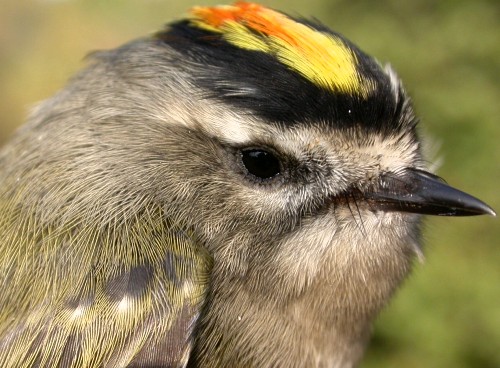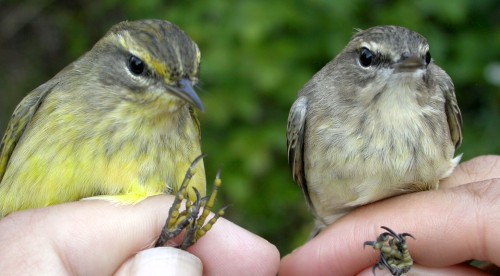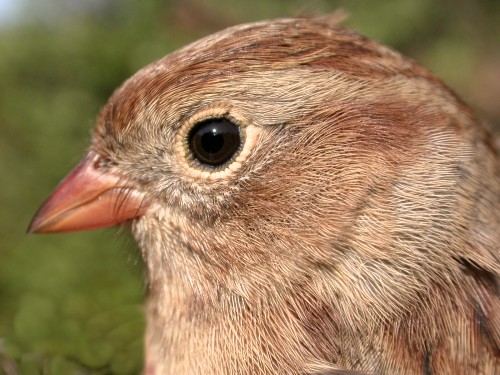|
McGILL BIRD OBSERVATORY |
|||||||||||||||||||||||||||||||||||||||||||||
Welcome to the McGill Bird Observatory weekly report. Click here for a complete listing of our archives. Comments or questions are welcome at mbo@migrationresearch.org.
Banders-in-charge:
Marcel Gahbauer, Barbara Frei, Marie-Anne Hudson Quiz: Can you identify the two birds in the photo below? Answer at the end of the weekly report.
Notes: We are pleased to report that ten weeks into our fall banding season, MBO continues to amaze us with new surprises. Monday through Thursday produced a remarkable number of birds despite a record-setting October heat wave. However, it was the waves of migrants streaming through over the weekend that were most remarkable. On Saturday, we set a new single-day October record with 54 species observed, including 8 warblers. Also observed were 5100 Canada Geese flying overhead, and a nice variety of raptors, highlighted by 5 Red-tailed Hawks. On Sunday the strong northeast winds continued, but the birds present were very different, with Canada Goose and White-throated Sparrow numbers way down, but kinglets much more abundant than we have ever seen before. With all but six nets closed due to wind, we still caught an incredible 136 Ruby-crowned and 65 Golden-crowned Kinglets during our five-hour session! This marks the first time we've caught over 200 birds in a day, and we never expected to achieve that total with just two species (all other birds on Sunday accounted for only an additional 20 individuals). However, our single-day banding record remains 132. How is this possible? The high number of birds this fall caught us off guard, and while we ordered more bands a week ago, we used our last 0A bands on Saturday and couldn't band a single one of the kinglets caught Sunday! Fortunately though we were at least able to record age and sex for the majority of individuals, allowing us to observe that after-hatch-year birds dominated among the Ruby-crowned Kinglets and hatch-year birds among the Golden-crowned, and that males greatly outnumbered females among the Ruby-crowned, while both sexes occurred in nearly equal numbers among the Golden-crowned. Had we had enough bands in stock, we would have ended up with a whopping total of 586 birds banded for the week, despite Friday being washed out with almost 70 mm of rain. Even so, we did manage to band 373, which is much higher than we would have expected this late in the season. Now that this cold front has moved through, our diversity and overall numbers will surely decline at last, though a core group of species including Slate-coloured Juncos, American Robins, Black-capped Chickadees, and American Tree Sparrows (soon to arrive) may well keep us busy enough through the final three weeks ahead. The colder weekend weather ushered in five new species for the season: American Black Duck, Osprey, Northern Goshawk, Dunlin, and Evening Grosbeak, the last two species never before observed at MBO. The only new species banded this week was Field Sparrow. Meanwhile, the persistent warm weather encouraged several species to stay much longer than usual, including 12 species of warbler! New late season records established for several species including Indigo Bunting (Oct 4), Red-eyed Vireo (Oct 6), Rose-breasted Grosbeak and Tennessee Warbler (Oct 8), and Brown Thrasher and Mourning Warbler (Oct 9). Had we been able to band them all, Ruby-crowned Kinglets would have dominated this week's list with 213, followed by Golden-crowned Kinglet with 81. However, thanks to the band shortage the White-throated Sparrow managed to remain the most-banded species for a fourth consecutive week, with 67. It was followed closely by Ruby-crowned Kinglet (66), then Black-capped Chickadee (52), Slate-coloured Junco (34), and Yellow-rumped Warbler (30). Only one night over the past week was at all suitable for Saw-whet Owl banding, and even then the conditions were marginal, with winds of at least 20-30 km/h throughout the evening. Despite billowing nets, falling leaves, and lots of noise from the wind, 3 owls were banded, giving us hope that we might get bigger numbers as conditions improve.
|




